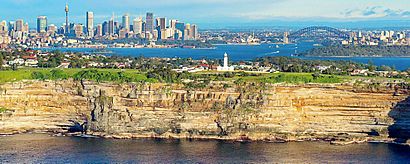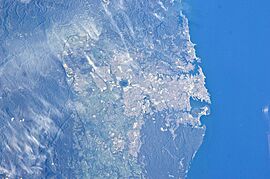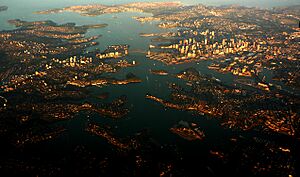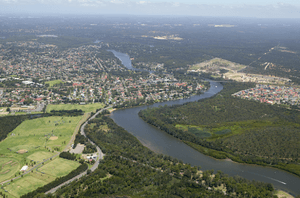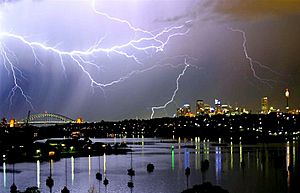Geography of Sydney facts for kids
The geography of Sydney is all about its special location. Sydney sits on the coast, surrounded by the Pacific Ocean to the east. To the west are the Blue Mountains, the Hawkesbury River is to the north, and the Woronora Plateau is to the south.
Sydney is on a special kind of coastline called a submergent coastline. This means that a very long time ago, the sea level rose and flooded deep river valleys that had been carved into the land. These flooded valleys are called rias. Port Jackson, which most people know as Sydney Harbour, is a perfect example of one of these rias.
The ground under Sydney is made of ancient rocks like Triassic shales (a type of soft rock) and sandstones. Most of the area has low, rolling hills and wide valleys. It's also in a bit of a rain shadow, meaning the Great Dividing Range of mountains blocks some of the rain. Sydney is spread out over two main areas:
- The Cumberland Plain: This is a fairly flat area west of Sydney Harbour.
- The Hornsby Plateau: This is a higher area north of the Harbour, reaching up to 200 metres (about 650 feet) high, with steep valleys cutting through it.
Lots of eucalyptus trees (gum trees) grow naturally in Sydney. The soils are often red and yellow. This environment is home to many kinds of birds, insects, reptiles, and mammals that you can often see even in the city areas.
Much of the city's water supply comes from smaller rivers that flow into the Nepean River. The Parramatta River is another important river that drains water from a large part of Sydney's western suburbs.
Greater Sydney is a large area. It stretches about 80 kilometres (50 miles) from Palm Beach in the north down to the Royal National Park in the south. It also goes about 80 kilometres (50 miles) from Bondi Beach in the east all the way to the Blue Mountains in the west.
Contents
What's Under Sydney? The City's Geology
The landmass under Sydney, called the Sydney Basin, stretches out under the ocean to the edge of the continental shelf. The deepest part of this basin is about 30 kilometres (19 mi) west of Sydney's city centre, near a place called Fairfield.
The sandstone rock you see around Sydney was formed from sand washed down from an area near Broken Hill, about 200 million years ago. You can even see ripple marks in the sandstone from the ancient river that carried the sand! These marks tell geologists (scientists who study rocks) that the sand came from even older rocks. There are also some volcanic rocks in hilly areas. The layers of rock in the Sydney Basin have been gently pushed up and folded over time, especially when the Great Dividing Range mountains were formed.
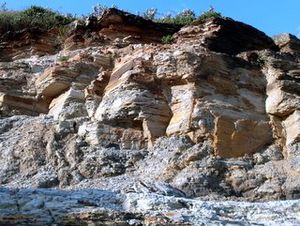
A long time ago, a large bend or slope, called a monocline, formed west of Sydney. This bend pushed the sandstone layer much higher than it would normally be. That's why the tops of the Blue Mountains are made of sandstone. You can see these sandstone slopes to the west (the Blue Mountains), and also to the north (the Hornsby Plateau) and south (the Woronora Plateau).
Sydney has two main types of soil:
- Sandy soils: These come from the Hawkesbury sandstone and don't have many nutrients for plants. They can be red, brown, yellow, or grey.
- Clay soils: These come from shales and volcanic rocks and are usually more fertile.
Some areas have a mix of both sandy and clay soils.
Sydney also has several islands in its harbour and nearby rivers. Some of these include Shark Island, Cockatoo Island, Clark Island, and Goat Island in Port Jackson (Sydney Harbour). There's also Bare Island in Botany Bay, and Lion Island in the Hawkesbury River.
Rivers and Creeks: Sydney's Waterways

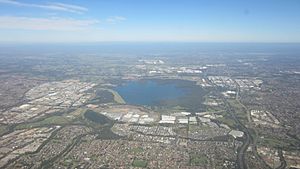
Sydney has nine main rivers and over a hundred smaller creeks. The Nepean River starts in the south and curves around the western edge of the city. There are swamps and lagoons (small lakes) near the Nepean, like Bents Basin, which is a popular spot for swimming and picnics.
When the Nepean River turns east, it becomes the Hawkesbury River. The Hawkesbury winds its way through the Hornsby Plateau and flows into Broken Bay. This area is generally seen as the boundary between Sydney and the Central Coast region to the north. The Warragamba River flows from the Warragamba Dam into the Nepean River.
The south and southwest parts of Sydney are drained by the Georges River. It starts near Appin, flows north towards Liverpool, and then turns east into Botany Bay. Another important river flowing into Botany Bay is the Cooks River, which runs through suburbs like Canterbury and Tempe. The Georges River separates the main part of Sydney from the Sutherland Shire. The Woronora River flows from the Woronora Dam into the Georges River. Further south, the Hacking River runs through The Royal National Park and into Port Hacking.
The Parramatta River starts from several creeks, like Toongabbie Creek and Hunts Creek. Near Parramatta, it becomes a tidal estuary (a partly enclosed coastal body of water where fresh water from rivers and streams mixes with salt water from the ocean) that flows into Port Jackson (Sydney Harbour). The Lane Cove River and Middle Harbour Creek also flow into Sydney Harbour from the North Shore.
Smaller waterways in Sydney's western suburbs include South Creek and Eastern Creek, which flow into the Hawkesbury River. Prospect Creek flows into the Georges River.
Sydney's Nature: Plants and Animals
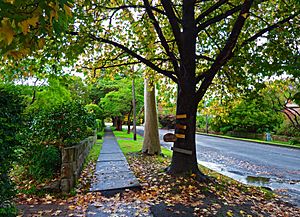
The main types of plant communities in the Sydney area are grassy woodlands. These are open forests with scattered tough-leafed shrubs and some grass underneath. You can also find wet and dry sclerophyll forests (eucalyptus forests). Heathlands (areas with low-growing shrubs) and even small patches of temperate or subtropical rainforest exist in some spots. This means Sydney has a few different types of natural environments, or biomes.
Dry sclerophyll forests are the most common type of forest. They look a bit like forests you might find near the Mediterranean Sea and have dry eucalyptus woodlands. Wet sclerophyll forests are found in cooler, wetter areas like the Northern Suburbs, Forest District, North Shore, and the Blue Mountains. These forests have taller, denser trees with a lot of shrubs and tree ferns underneath.
These sclerophyll forests developed because Australia is a very old continent and because of how Aboriginal people used fire for thousands of years. The ancient rocks have been weathered down so much that the soils are poor in nutrients. Because plants can't afford to lose their leaves to animals when nutrients are scarce, they protect their leaves with toxins (natural poisons). In eucalyptus trees, these toxins create the unique smell of the Australian bush.
Animals in Sydney
Sydney is home to a wide variety of animals. Even in the city, you can find many types of birds and insects, as well as some bats, arachnids (like spiders), and amphibians (like frogs). Common bird species in Sydney include:
- Australian white ibis
- Australian raven (crow)
- Australian magpie
- Crested pigeon
- Grey butcherbird
- Magpie lark
- Noisy miner
- Pied currawong
- Silver gull (seagull)
- Willie wagtail
You'll also see birds that were brought from other countries, like the house sparrow, common myna, and feral pigeon (city pigeon), especially in busy city areas.
Other animals like possums, bandicoots, rabbits, feral cats, lizards, snakes, and frogs can also be found in urban areas, but usually not right in the city centre.
Sydney's Weather
Sydney has a humid subtropical climate (Cfa). This means it usually has warm and sometimes hot summers, and mild to cool winters.
The warmest month is January. The average temperature ranges from 19.6–26.5 °C (67.3–79.7 °F). The coldest month is July, with an average temperature range of 8.7–17.4 °C (47.7–63.3 °F). Sometimes in late spring and summer, hot, dry winds from the Outback (Australia's desert areas) can make temperatures in Sydney soar above 40 °C (104.0 °F). Frost can sometimes occur in the outer suburbs during winter.
Rainfall is spread throughout the year, but it's a bit heavier in the first half of the year. Sydney's coastal areas usually get around 1,000 mm (39.37 in) to 1,200 mm (47.24 in) of rain each year. The western suburbs get less rain, around 800 mm (31.50 in) to 900 mm (35.43 in), because the moist winds from the ocean don't always reach that far inland. Sometimes, big weather systems called East Coast Lows can bring heavy rain, especially in late autumn and winter.
Interesting facts about the geography of Sydney
- Underneath Sydney, there are about six kilometres of sandstone and shale!
- Researchers at the Massachusetts Institute of Technology (MIT) found that Sydney has a Green View Index of 25.9%. This means that about a quarter of the city is covered by urban trees. This makes Sydney one of the greenest major cities in the world.
- Sydney has more than 70 beaches along its harbour and oceanfront!
- As of 2016, over 5 million people lived in Sydney, and the city keeps growing.
- The main city part of Sydney covers about 1,788 km2 (690 sq mi).
- Scientists estimate that about half of the native vegetation that was here when Europeans arrived still remains in the Sydney area.
See also
- Sydney basin
- Geology of New South Wales
- Geology of Australia
- Cumberland Plain Woodland
- Sydney sandstone
- Bald Hill Claystone
- Geography of Australia
- Geography of New South Wales
- List of beaches in Sydney


